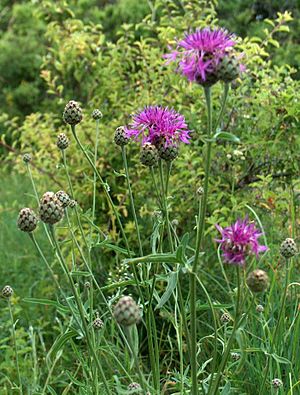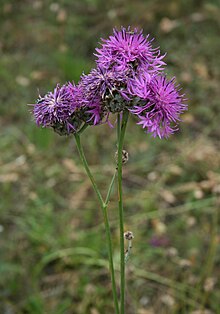Scabies knapweed
| Scabies knapweed | ||||||||||||
|---|---|---|---|---|---|---|---|---|---|---|---|---|

Scabiosa knapweed ( Centaurea scabiosa ) |
||||||||||||
| Systematics | ||||||||||||
|
||||||||||||
| Scientific name | ||||||||||||
| Centaurea scabiosa | ||||||||||||
| L. |
The Marsh knapweed ( Centaurea scabiosa ) is a plant from the genus of knapweed ( Centaurea ) within the family of Compositae (Asteraceae).
description
The scabiosa knapweed is a perennial herbaceous plant that can reach heights of up to 1.20 m. It has an angular, rough stem that forms upright branches above the center, which are not sparsely branched. The green and leathery, usually only slightly hairy leaves are pinnate. The plumage sections are elongated or narrowly lanceolate in shape.
The single flowers stand together in a single terminal head, which is about 2 cm high in diameter and up to 4 cm wide. The bracts (see fig.) Have no nerves. The frayed appendages have a toothed or eyelashed hem on the edge that runs down relatively far. The color of the petals varies from dark purple to purple or light red to rarely even white. The pappus is almost as long as the achenes .
The flowering period is June to August.
The number of chromosomes is 2n = 20, less often 40.
ecology

The spread of Achänenfrüchte done by ants , and they are also wind spreader and through the "hakelnden" husks and animal spreader .
Of all native plants, except for those of the oak genus , it is most affected by gall wasps. An infestation can be recognized by thick, egg-shaped swellings on the stems .
The wild meadow plant survives the winter as a hemicryptophyte with the help of its turnip-like taproot. In spring, vegetative root shoots can also be formed from it. It has roots up to 200 cm deep. The self-sterile flowers are only pollinated by insects.
Occurrence
The scabiosa knapweed can be found on dry or semi-arid grassland, in moderately dry ruderal areas on roadsides or on dry meadows. In Central Europe it is a species of the Festuco-Brometea class. It also occurs on extensively used fields and on subalpine stone lawns. It prefers calcareous soils. It rises in the subspecies Centaurea scabiosa subsp. alpestris in the Tyrolean part of the Allgäu Alps on the Gampensattel up to 2200 meters above sea level. In Germany, their frequency ranges from absent-minded to relatively frequent. It is a plant of the dry to semi- arid grassland and is also found in the rest of Europe as far as West Asia. It is found as a neophyte in a few parts of North America . Naturally, the scabiosa knapweed only grows in the temperate latitudes from the flat to the hill country of the northern hemisphere.
Systematics
One can distinguish the following subspecies:
- Centaurea scabiosa L. subsp. scabiosa
- Centaurea scabiosa subsp. adpressa (Ledeb.) Gugler : It occurs in Ukraine, Russia, Moldova, Romania, Slovakia and Transcaucasia.
- Centaurea scabiosa subsp. alpestris (Hegetschw.) Nyman : It occurs on subalpine stone lawns in the Alps and is characterized by black envelope leaves. It is a character species of the order Seslerietalia albicantis. Its distribution area includes France, Switzerland, Liechtenstein, Austria, Germany, Italy, Slovakia, the former Yugoslavia, Poland and the Ukraine.
- Centaurea scabiosa subsp. apiculata (Ledeb.) Mikheev : It occurs in Belarus, Ukraine, Russia, Moldova and Transcaucasia.
- Baden's scabiosa knapweed ( Centaurea scabiosa subsp. Badensis (Tratt.) Gugler ): It is a 30–80 cm high clan and occurs in the Alps of Austria from Baden to Vienna. The distribution area includes Austria, the Czech Republic and Slovakia.
- Centaurea scabiosa subsp. cephalariifolia (Willk.) Greuter (Syn .: Centaurea cephalariifolia Willk. ): It occurs in Spain.
- Centaurea scabiosa subsp. fritschii (Hayek) Hayek : It occurs in Austria, Hungary, Slovakia, Italy, the Balkan Peninsula, Bulgaria and Romania.
- Centaurea scabiosa subsp. grinensis (Reut.) Nyman (Syn .: Centaurea grinensis Reut. ): It occurs in Italy, France and Switzerland.
- Centaurea scabiosa subsp. integra Greuter (Syn .: Centaurea integrifolia exchange ): It occurs in Eastern European Russia.
- Centaurea scabiosa subsp. menteyerica (Chaix) Nyman (Syn .: Centaurea menteyerica Chaix ): It occurs in France and Italy.
- Centaurea scabiosa subsp. sadleriana (Janka) Asch. & Graebn. : It occurs in Austria, Hungary, Serbia, Slovakia and Romania.
- Centaurea scabiosa subsp. spinulosa (explosive) Arcang. (Syn .: Centaurea spinulosa Spreng. ): It occurs in Hungary, on the Balkan Peninsula, in Bulgaria and in Romania.
- Centaurea scabiosa subsp. tematinensis (Domin) Domin (Syn .: Centaurea scabiosa subsp. vertesensis (Boros) Soó ): It occurs in Hungary.
Common names
The other common German names for the scabiosa knapweed existed or existed : Eisenwurzel ( Silesia ), Knauf ( Eifel near Kerpen ), Knoop ( Mecklenburg ), Knopfwurzel (Silesia), Kowatsch ( Pomerania ), Lämmerridpen ( Carinthia in the Mölltal ) and Papenklöten (Mecklenburg).
swell
- Dietmar Aichele, Marianne Golte-Bechtle: What is blooming there? 54th edition. Kosmos Verlag, 1991, ISBN 3-440-05615-5 .
- Robert Zander : Zander concise dictionary of plant names. Edited by Fritz Encke , Günther Buchheim, Siegmund Seybold . 15th edition, corrected reprint of the 14th edition. Eugen Ulmer, Stuttgart 1994, ISBN 3-8001-5072-7 .
- Ruprecht Düll , Herfried Kutzelnigg : Pocket dictionary of plants in Germany and neighboring countries. The most common Central European species in portrait. 7th, corrected and enlarged edition. Quelle & Meyer, Wiebelsheim 2011, ISBN 978-3-494-01424-1 .
- Raimund Fischer: Blossom diversity in the Pannonian. Plants in eastern Lower Austria, northern Burgenland and Vienna. IHW-Verlag, Eching near Munich 2004, ISBN 3-930167-51-4 .
Individual evidence
- ↑ a b c d Erich Oberdorfer : Plant-sociological excursion flora for Germany and neighboring areas . With the collaboration of Angelika Schwabe and Theo Müller. 8th, heavily revised and expanded edition. Eugen Ulmer, Stuttgart (Hohenheim) 2001, ISBN 3-8001-3131-5 , pp. 973-974 .
- ↑ Erhard Dörr, Wolfgang Lippert : Flora of the Allgäu and its surroundings. Volume 2, IHW, Eching 2004, ISBN 3-930167-61-1 , p. 646.
- ↑ a b c d e f g h i j k l m Werner Greuter (2006+): Compositae (pro parte majore). - In: W. Greuter & E. von Raab-Straube (ed.): Compositae. Euro + Med Plantbase - the information resource for Euro-Mediterranean plant diversity. Datasheet Centaurea scabiosa In: Euro + Med Plantbase - the information resource for Euro-Mediterranean plant diversity.
- ^ Georg August Pritzel , Carl Jessen : The German folk names of plants. New contribution to the German linguistic treasure. Philipp Cohen, Hannover 1882, page 87. ( online ).
Web links
- Scabies knapweed. In: FloraWeb.de.
- Scabies knapweed . In: BiolFlor, the database of biological-ecological characteristics of the flora of Germany.
- Profile and distribution map for Bavaria . In: Botanical Information Hub of Bavaria .
- Centaurea scabiosa L. s. st. In: Info Flora , the national data and information center for Swiss flora . Retrieved June 20, 2016.
- Centaurea scabiosa subsp. alpestris (Hegetschw.) Nyman In: Info Flora , the national data and information center for Swiss flora . Retrieved June 20, 2016.
- Centaurea scabiosa subsp. grinensis (Reut.) Nyman In: Info Flora , the national data and information center for Swiss flora . Retrieved June 20, 2016.
- Distribution in the northern hemisphere
- Thomas Meyer: Knapweed data sheet with identification key and photos at Flora-de: Flora von Deutschland (old name of the website: Flowers in Swabia )


